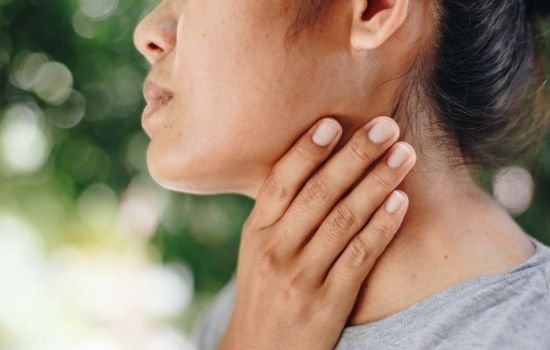All AO locations will be closed on Thursday, January 1, for the New Year's Day holiday. We will reopen on Friday, January 2.
January 11, 2024
Types of Radiation Therapy Used for Head and Neck Cancers

Radiation therapy is a standard part of the treatment process for most patients diagnosed with a type of head and neck cancer, like laryngeal, hypopharyngeal, oral, or sinus cavity cancers. External beam radiation therapy uses high-energy x-rays targeted at the tumor to destroy cancer cells.
For some patients, radiation may be the primary treatment. Radiation for head and neck cancer is also used in combination with surgery to help shrink tumors before removal. It is also used after surgery to help prevent recurrent cancer or to treat tumors that develop in other areas of the body. In addition to radiation and surgery, chemotherapy may also be used in combination with radiation. Ultimately, several factors help determine if and when radiation therapy is included in the treatment process based on the cancer's location, stage, and your current health condition.

Types of External Beam Radiation Used for Head & Neck Cancers
External beam radiation is the most common type of radiation treatment used for head and neck cancers. This approach requires the patient to remain completely still under a machine called a linear accelerator while the treatment is given. The radiation therapy team can even monitor your breathing pattern to be sure the radiation is only delivered when you’re not inhaling. This allows it to be delivered precisely where it needs to go during every treatment.
The specific type of external beam radiation used for each patient depends on the type and location of the cancer. Radiation oncologists will evaluate each patient to determine which type of treatment would be best. They will also do what they can to help you avoid side effects.
Intensity-Modulated Radiation Therapy
Intensity-modulated radiation therapy (IMRT) treats head and neck cancers as well as many other types of cancer. Imaging is used to plan the treatment process. A CT scan is often used, but sometimes an MRI scan can identify the shape and location of the tumor.
Based on the images, the radiation oncologist will create a treatment plan that sends beams of radiation at varying levels of intensity to match the exact size and shape of the tumor. This helps to protect healthy organs and tissue that are near the tumor and cancerous cells.
Most patients who receive IMRT will receive therapy five days a week for 4-8 weeks. Learn more about how IMRT works.
Image-Guided Radiation Therapy (IGRT)
IGRT, or image-guided intensity-modulated radiation therapy, utilizes various imaging approaches to help guide your treatment in real time—some of the different types of images used are CT, MRI, or PET scans. Imaging is combined with specialized software to guide the radiation to the exact treatment area.
To use this method, daily imaging scans are used that allow your medical team to determine an accurate position for the radiation to be delivered. The images are also processed by the software that maps changes in the location or size of the tumor. The radiation therapy team uses this information to guide the delivery of your radiation treatments during the procedure.
Stereotactic Body Radiation Therapy
Stereotactic body radiation therapy (SBRT) delivers a high dose of radiation in each session. It’s most often used to treat laryngeal cancer because it can help the oncologist avoid the vocal cords. It’s also used for recurrent head and neck cancers. Most patients have only one to five total sessions.
Stereotactic Radiosurgery
Stereotactic radiosurgery (SRS) is sometimes used as part of the treatment for head and neck cancers. It can treat hard-to-reach areas or, in some cases, as an additional treatment after other external beam radiation therapy.
SRS uses several radiation beams positioned from different directions at the tumor. This strategic positioning allows for a targeted dose at the focal point of the beams. Individual beams have little impact on the healthy tissue as they pass through, but when the combined energy of the beams meets the tumor, it can effectively destroy those cells.
Because all the beams are focused at a single location, the patient is immobilized, delivering the treatment only to the targeted area. This treatment is usually completed in a single treatment but can also be given over several days.
Is Internal Radiation Therapy an Option for Head & Neck Cancers?
In some cases, internal radiation therapy, also called brachytherapy, is a treatment option for head and neck cancers. When used, it’s often for recurrent cancer. High-dose-rate (HDR) brachytherapy is the most commonly used approach. The radiation is delivered through an applicator placed in the body or through an applicator placed outside the body, often in the mouth area.
The radioactive material is placed in the applicator for a few minutes and then removed. This is typically repeated once or twice daily for two to five days.
Side Effects of Radiation for Head and Neck Cancers
While radiation treatments and oncologists are continually looking to reduce the potential for side effects, there are still several side effects associated with using radiation in the treatment of head and neck cancers. Several organs are located in the head and neck which can be affected by the radiation, even if it’s not the primary targeted area. Some effects can be on these nearby areas and structures. Some of the side effects can include:
Reduced Thyroid Function: Your thyroid is located in the neck and is more likely to be exposed to radiation therapy. The thyroid is particularly sensitive to radiation and can slow down or cause the thyroid to stop functioning. Cancer care teams observe thyroid function very closely throughout treatments.
Difficulty Swallowing: This can be due to a sore throat or inflammation in the tissue where radiation is given.
Hoarse Voice: Radiation delivered near the voice box can temporarily or permanently alter the voice. This is dependent on how much radiation is given to the area.
Tooth Decay or Loss: Tooth loss can occur if the teeth or gums are exposed to radiation. Your cancer care team will coordinate with your dentist to help prevent and minimize tooth loss.
Dry Mouth: Radiation exposure can cause the salivary glands to stop working. This produces a dry mouth. There are mouth rinses that can help alleviate some of these symptoms. Dry mouth can be a permanent or temporary side effect.
The Right Head and Neck Cancer Treatment Plan for You
If you’re located in the South Chicago suburbs, the Affiliated Oncologists team is here to consult with you and provide a personalized treatment plan for your specific type and stage of head and neck cancer. Your oncology team will guide you through a recommended treatment plan most likely to benefit you. They will also help you reduce and manage the side effects of treatment to the best of their ability.

If you will receive radiation therapy, choosing a radiation oncology center close to where you live or work is important since you will frequently visit over a month or so. You can also check out the answers to frequently asked questions about radiation therapy. Schedule an appointment with a member of our team at a location of your choice.
Categories: Head and Neck Cancers